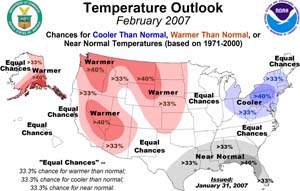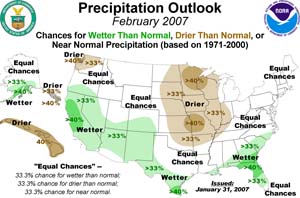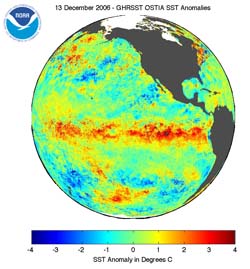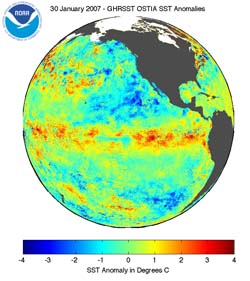| NOAA Magazine || NOAA Home Page |
NOAA's
FEBRUARY OUTLOOK BRINGS ON THE CHILL
Weakening El Niño To Exert Little Influence
 Feb.
1, 2007 � Following an overall mild December and most of January, the
current chill over much of the U.S. will persist through early February,
according to seasonal forecasters at the NOAA
Climate Prediction Center. Below-normal temperatures are expected
to dominate the central and eastern part of the country through early
February with more moderate temperatures projected for the final weeks
of the winter season. Climatologically, winter is comprised of the months
of December, January and February. (Click NOAA image for larger
view of February 2007 temperature outlook. Click
here for high resolution version. Please credit “NOAA.”)
Feb.
1, 2007 � Following an overall mild December and most of January, the
current chill over much of the U.S. will persist through early February,
according to seasonal forecasters at the NOAA
Climate Prediction Center. Below-normal temperatures are expected
to dominate the central and eastern part of the country through early
February with more moderate temperatures projected for the final weeks
of the winter season. Climatologically, winter is comprised of the months
of December, January and February. (Click NOAA image for larger
view of February 2007 temperature outlook. Click
here for high resolution version. Please credit “NOAA.”)
 "This
winter got off to a very warm start, but it is ending with more seasonable
temperatures and precipitation over most of the U.S.," said Mike
Halpert, meteorologist at the NOAA Climate Prediction Center. Last November,
NOAA's winter outlook called for warmer-than-normal temperatures, although
cooler than last year's very warm winter season. "With one month
to go in the season, that forecast is shaping up quite well." (Click
NOAA image for larger view of February 2007 precipitation outlook. Click
here for high resolution version. Please credit “NOAA.”)
"This
winter got off to a very warm start, but it is ending with more seasonable
temperatures and precipitation over most of the U.S.," said Mike
Halpert, meteorologist at the NOAA Climate Prediction Center. Last November,
NOAA's winter outlook called for warmer-than-normal temperatures, although
cooler than last year's very warm winter season. "With one month
to go in the season, that forecast is shaping up quite well." (Click
NOAA image for larger view of February 2007 precipitation outlook. Click
here for high resolution version. Please credit “NOAA.”)
News
Audio (mp3), NOAA Weather Building, Camp Springs, Md.
|
 Louis
W. Uccellini (oo-cheh-lee-nee), director of the NOAA National Centers
for Environmental Prediction, part of the NOAA National Weather
Service, said El Niño is collapsing and the USA can expect
winter weather the next two to three weeks. 1:45 Louis
W. Uccellini (oo-cheh-lee-nee), director of the NOAA National Centers
for Environmental Prediction, part of the NOAA National Weather
Service, said El Niño is collapsing and the USA can expect
winter weather the next two to three weeks. 1:45 |
| Uccellini said El Niño is collapsing. :16 |
| Uccellini said so far this year has not been a typical El Niño winter. :15 |
NOAA's temperature outlook for February favors above-normal temperatures over much of the West, northern Plains and much of Alaska with near-average temperatures in the Southeast, and below-average temperatures in parts of the Midwest, Northeast and mid-Atlantic. February temperatures in the western Great Lakes, southern mid-Atlantic, Tennessee Valley, Southwest and Hawaii have equal chances for being above-, near- or below-average.
 Precipitation
during February is expected to be above average throughout much of the
southern U. S. from California to Florida and the south Atlantic Coast,
and in southern Alaska and below median in the Missouri Valley, the
western Great Lakes, the Alaskan Panhandle, much of Washington state
and Hawaii. Equal chances of above-, near-, or below median precipitation
is anticipated elsewhere. (Click NOAA satellite image for larger
view of sea surface temperature anomalies in the Eastern Pacific Ocean
taken Dec. 13, 2006, when El Niño was at its peak. Please credit
“NOAA.”)
Precipitation
during February is expected to be above average throughout much of the
southern U. S. from California to Florida and the south Atlantic Coast,
and in southern Alaska and below median in the Missouri Valley, the
western Great Lakes, the Alaskan Panhandle, much of Washington state
and Hawaii. Equal chances of above-, near-, or below median precipitation
is anticipated elsewhere. (Click NOAA satellite image for larger
view of sea surface temperature anomalies in the Eastern Pacific Ocean
taken Dec. 13, 2006, when El Niño was at its peak. Please credit
“NOAA.”)
Meanwhile in the tropical Pacific Ocean, El Niño conditions are weakening as water temperatures have trended towards normal during recent weeks. "Any El Niño-related effects over North America should be minimal during the remainder of the winter season," said Vernon Kousky, research meteorologist at the NOAA Climate Prediction Center. "A return to neutral conditions in the tropical Pacific is expected this spring."
 NOAA
forecasters caution everyone to keep safe this season. Cooler temperatures
combined with above-normal precipitation can often mean a wintry mix
of sleet, snow and freezing rain. The NOAA National Weather Service
has a wealth of weather safety information, including news and information,
online to help keep you ahead of the winter storm. (Click NOAA
satellite image for larger view of sea surface temperature anomalies
in the Eastern Pacific Ocean taken Jan. 30, 2007, showing a weakening
El Niño. Please credit “NOAA.”)
NOAA
forecasters caution everyone to keep safe this season. Cooler temperatures
combined with above-normal precipitation can often mean a wintry mix
of sleet, snow and freezing rain. The NOAA National Weather Service
has a wealth of weather safety information, including news and information,
online to help keep you ahead of the winter storm. (Click NOAA
satellite image for larger view of sea surface temperature anomalies
in the Eastern Pacific Ocean taken Jan. 30, 2007, showing a weakening
El Niño. Please credit “NOAA.”)
NOAA, an agency of the U.S. Commerce Department, is celebrating 200 years of science and service to the nation. From the establishment of the Survey of the Coast in 1807 by Thomas Jefferson to the formation of the Weather Bureau and the Commission of Fish and Fisheries in the 1870s, much of America's scientific heritage is rooted in NOAA. NOAA is dedicated to enhancing economic security and national safety through the prediction and research of weather and climate-related events and information service delivery for transportation, and by providing environmental stewardship of the nation's coastal and marine resources. Through the emerging Global Earth Observation System of Systems (GEOSS), NOAA is working with its federal partners, more than 60 countries and the European Commission to develop a global monitoring network that is as integrated as the planet it observes, predicts and protects.
Relevant Web Sites
NOAAWatch: Storms & Hazards
NOAA Climate Prediction Center
NOAA
El Niño/Southern Oscillation (ENSO) Diagnostic Discussion
NOAA
Hydrometeorological Prediction Center
NOAA Weather Portal
Media
Contact:
Carmeyia Gillis, NOAA
Climate Prediction Center, (301) 763-8000 ext. 7163
(Sea surface temperature images were generated using GODAE
High Resolution SST data (UK Met Office OSTIA and AVHRR Pathfinder)
at the NOAA National Oceanographic Data Center.)